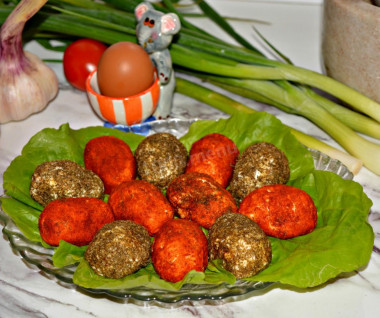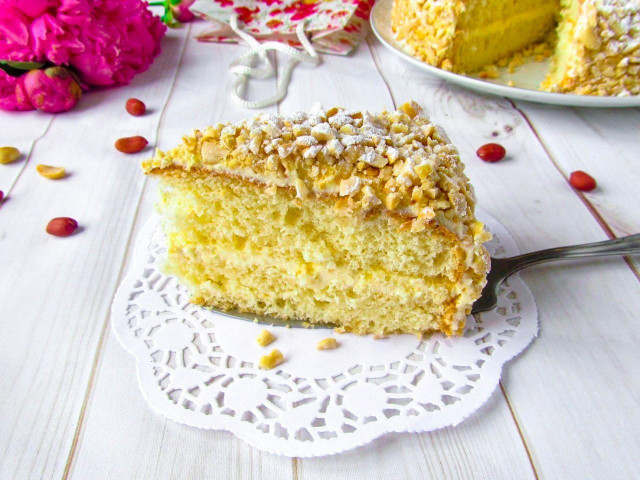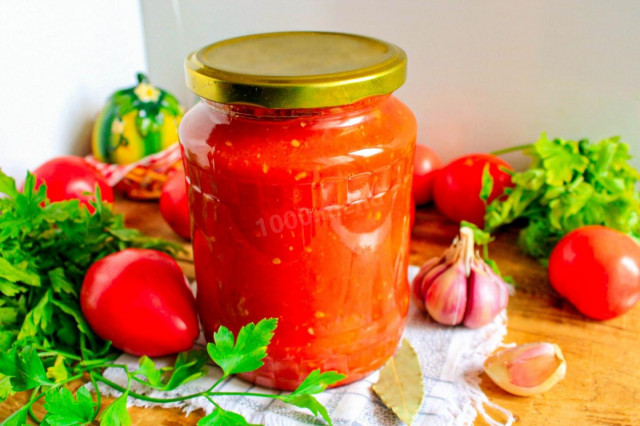Composition / ingredients
Step-by-step cooking
Step 1:

Prepare all the necessary products. Boil and peel the eggs from the shell, open a jar of olives (I have stuffed with lemon), peel one clove of garlic. It is advisable to put the melted cheese in the freezer in advance so that it is easier to rub.
Step 2:

Grate the hard cheese on a fine grater.
Step 3:
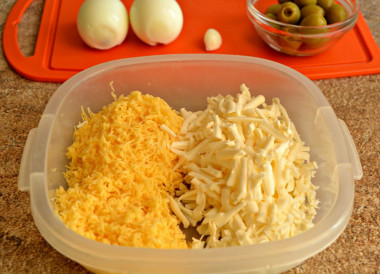
The melted cheese is also grated.
Step 4:
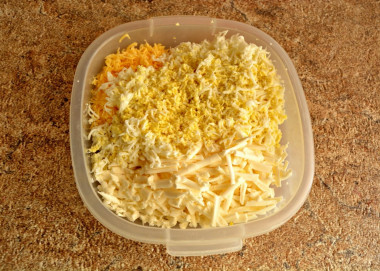
Then grate boiled eggs and a clove of garlic on a fine grater.
Step 5:
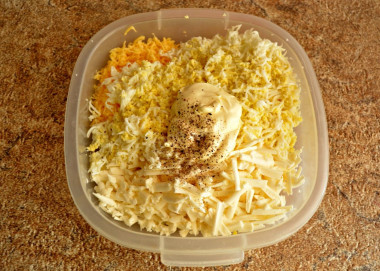
Add mayonnaise, salt and pepper.
Step 6:
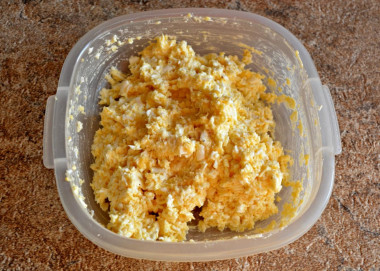
Knead the cheese mass well.
Step 7:

We make cheese eggs from the cheese mass, constantly wetting our hands in cold water (it is better to use disposable gloves). At the same time, we hide a surprise (an olive) inside each testicle. Inside each egg, you can hide a variety of surprise fillings, or you can leave the eggs without filling, since the cheese mass is delicious in itself. Instead of olives, you can hide anything, for example, a walnut, pistachio or a piece of salted red fish.
Step 8:

In this way, we mold cheese eggs from the whole mass.
Step 9:

As a "dye" for eggs, we will use paprika and dried dill. Instead of dried dill, you can take fresh finely chopped. Also, crushed walnuts, peanuts or fried sesame seeds can be used to sprinkle cheese eggs.
Step 10:
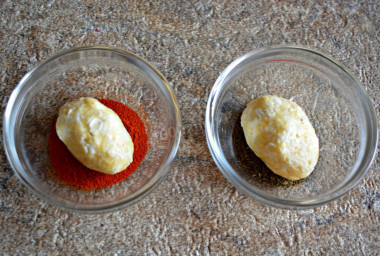
We roll each cheese egg in our "dyes " and get real Easter "krashenki ".
Step 11:

Cheese eggs are laid out on lettuce leaves and served to the table.
To make it convenient for guests to take cheese eggs from the table, you can stick a beautiful toothpick into each egg. You can also prick a piece of sausage, fish or a thin slice of lemon on a toothpick and you will get wonderful canapes. It all depends on your imagination. After all, cooking is creativity for the soul!
Bon appetit and new culinary successes! Happiness and goodness to your home!
Caloric content of the products possible in the composition of the dish
- Chicken egg - 157 kcal/100g
- Egg white - 45 kcal/100g
- Egg powder - 542 kcal/100g
- Egg yolk - 352 kcal/100g
- Ostrich egg - 118 kcal/100g
- Dutch cheese - 352 kcal/100g
- Swiss cheese - 335 kcal/100g
- Russian cheese - 366 kcal/100g
- Kostroma cheese - 345 kcal/100g
- Yaroslavsky cheese - 361 kcal/100g
- Altai cheese 50% fat content - 356 kcal/100g
- Soviet cheese - 400 kcal/100g
- Cheese "steppe" - 362 kcal/100g
- Uglich cheese - 347 kcal/100g
- Poshekhonsky cheese - 350 kcal/100g
- Lambert cheese - 377 kcal/100g
- Appnzeller cheese with 50% fat content - 400 kcal/100g
- Chester cheese with 50% fat content - 363 kcal/100g
- Edamer cheese with 40% fat content - 340 kcal/100g
- Cheese with mushrooms of 50% fat content - 395 kcal/100g
- Emmental cheese with 45% fat content - 420 kcal/100g
- Gouda cheese with 45% fat content - 356 kcal/100g
- Aiadeus cheese - 364 kcal/100g
- Dom blanc cheese (semi-hard) - 360 kcal/100g
- Lo spalmino cheese - 61 kcal/100g
- Cheese "etorki" (sheep, hard) - 401 kcal/100g
- White cheese - 100 kcal/100g
- Fat yellow cheese - 260 kcal/100g
- Altai cheese - 355 kcal/100g
- Kaunas cheese - 355 kcal/100g
- Latvian cheese - 316 kcal/100g
- Limburger cheese - 327 kcal/100g
- Lithuanian cheese - 250 kcal/100g
- Lake cheese - 350 kcal/100g
- Gruyere cheese - 396 kcal/100g
- Garlic - 143 kcal/100g
- Processed cheese with 60% fat content - 354 kcal/100g
- Processed cheese with 45% fat content - 294 kcal/100g
- Cheese "megle" - 590 kcal/100g
- Tartar cheese - 348 kcal/100g
- Cheese "cheese "shavru" (goat) - 173 kcal/100g
- Viola cheese - 307 kcal/100g
- Ground black pepper - 255 kcal/100g
- Dill greens - 38 kcal/100g
- Olives - 115 kcal/100g
- Salad mayonnaise of 50% fat content - 502 kcal/100g
- Light mayonnaise - 260 kcal/100g
- Provencal Mayonnaise - 624 kcal/100g
- Provencal mayonnaise - 627 kcal/100g
- Table mayonnaise - 627 kcal/100g
- Salt - 0 kcal/100g
- Paprika - 289 kcal/100g
- Lettuce leaves - 12 kcal/100g


